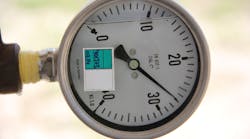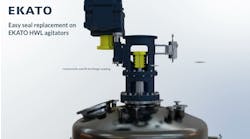Seeing is Believing: Field Test Vacuum Systems for Accurate Troubleshooting
During a recent troubleshooting project on a client’s vacuum system, I encountered two critical problems that are common in process plants. First, the history of how plants report vacuum pressures creates much confusion. Second, when data doesn’t make sense, get the measurements yourself.
My client’s problem involved unstable operating pressures in a lubricant manufacturing process. Swings in vacuum pressure created both composition control and product contamination problems. The advanced controller in the plant used measured temperatures on a distillation column as part of the logic to infer composition. When vacuum pressures varied outside a relatively narrow range, the controller’s estimated composition was incorrect. Additionally, changes in vacuum pressure significantly changed vapor velocity, leading to liquid entrainment at low pressures, which contaminated the final product.
Just discussing vacuum system operation led to massive confusion. The unit operators tended to talk in terms of inches of mercury, but the unit engineers liked to use millimeters of mercury. At first glance, a simple 25.4 conversion factor should convert inches to millimeters. However, it doesn’t. In most plants, including this one, inches of mercury is the pressure below atmospheric pressure and millimeters of mercury defines an absolute pressure.
For inches of mercury, the relationship to absolute pressure is:
Absolute pressure = barometric pressure - vacuum (in inches of Hg)
Feeling the Pressure
If we start assuming that barometric pressure is a standard atmosphere of 29.92 inches of mercury (14.696 psia), then a pressure of 28 inches of mercury (from barometric) would be an absolute pressure of 1.92 inches of mercury (29.92-28) or an absolute pressure of 48.8 mm of mercury.
Unfortunately, the story doesn’t end here. The key element is the assumption that barometric pressure is a standard atmosphere. Variations in local pressure can cause problems. If the pressure reading, either in the plant instrumentation or on the local gauge, is an absolute pressure reading or is compensated for the actual local pressure at the time of the reading, then there isn’t a problem. Fortunately, most plant vacuum instrumentation uses either absolute pressure gauges or does include compensation. That’s also true of many modern portable instruments used to measure vacuum pressures.
However, it’s not always true. Uncompensated readings can have significant errors. Local air pressure varies with both weather and elevation. For example, as I write this column, the barometric pressure variation just due to normal weather in Houston over the last 72 hours was 764 mmHg to 774 mmHg. For the previous example of 28 inches of mercury, this is equal to a variation of over 20% of the vacuum pressure if the pressure readings are not compensated.
Another example would be a plant in Denver. The local pressure in Denver averages around 638 mmHg absolute (25.1 inches of mercury absolute). Taking an uncompensated reading in Denver would have an error of over 100%.
Overreliance on Tribal Knowledge
In conversations with the client, it became evident that the staff didn’t fully understand the difference between absolute measurements in mmHg and measurements below barometric in inches of mercury. Also, while the plant control system data was always pressure compensated, not all the field measurements were correctly compensated. The mismatch of data made understanding the operation difficult.
The first task for the client was ensuring its additional field readings were accurate. But it took some effort getting everyone to agree further verification was necessary. A couple days later, I took pressure readings with the operators. At first, access to the vacuum system looked straightforward, with nice stairs leading to the unit. Both the operator and I turned a corner and then had to stop. The stairwell was filled with stacked scaffolding. A close look at the scaffolding pieces and their rust stains showed the scaffolding had been filling the stairwell for a while. Standing in the last section of accessible stairwell, we could see the vacuum system but couldn’t get any access unless we used a crane to lift us to the structure.
Upon returning to the control, the obvious question was, “How have you been getting these local pressure readings to solve the problem?” After some minutes of strained silence, someone replied that the pressure readings were “experienced-based” estimates they sent to the engineers in their offices. They hadn’t taken any field readings for a long time.
This story raises many questions. But the immediate issue was the lack of local readings. Experience-based estimates are not sufficient to troubleshoot process-critical systems. Go to the problem source, observe what’s going on and verify what you’re hearing from the field.



